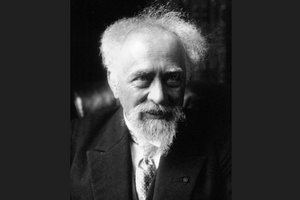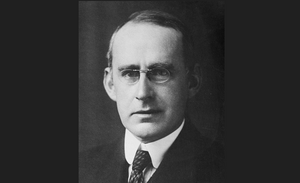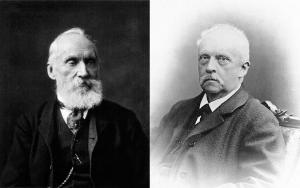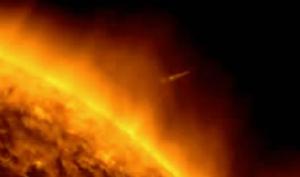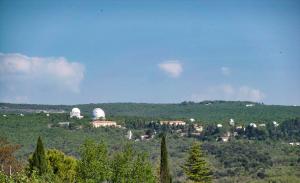The long path to discovery
A little more than one century ago, in 1919, a nagging question received the beginning of an answer. Almost simultaneously, two eminent scientists, Jean Perrin (1870-1942) in France and Arthur Eddington (1882-1944) in the United Kingdom, speculated that the energy source at the core of the Sun was to be found in sub-atomic reactions. Their intuition was a huge departure from the theories that had prevailed for the previous seven decades.
Armed with the science of the mid-19th century, physicists and astronomers had long thought that "solar heat" resulted from the constant fall of meteors and asteroids into the Sun. In 1841, calculations by Julius von Mayer (1814-1878), a German physician and chemist, indicated that asteroids striking the Sun at high velocity would generate "from 4,600 to 9,200 times as much heat as would be generated by the combustion of an equal mass of coal." There was a flaw in the model, however: in order to keep the Sun shining, a huge number of asteroids would be required and no one could explain where they would come from.
The "gravitational contraction" theory, first proposed by Hermann von Helmholtz (1821-1894) was much more satisfying for a scientific mind. According to the German physicist and physician, the pressure generated by gravitational forces from the prodigious mass of the Sun was responsible for the heat generated. Developed, expanded and refined by William Thomson (1824-1907), better known as Lord Kelvin, the Helmholtz-Thomson model held for more than four decades. But not without being challenged ...
While the nature of the Sun's energy source kept a large proportion of the scientific community busy, others were preoccupied by the age of the Earth. In Darwin's wake, biologists needed a very ancient Earth to allow for the patient process of evolution, as did geologists seeking to account for the stacking of rock strata and sediments they had begun exploring. For Earth, which was necessarily younger than the Sun, a minimum of 200 million years was required, yet the Helmholtz-Thomson model provided only for a 20- to 50-million-year-old Sun. Something had to give.
Not only did the "gravitational contraction" model assign an age to the Sun, it also projected its life expectancy, which did not exceed another few dozen million years. Unless, as Thomson wrote in 1891, "sources now unknown to us are prepared in the great storehouse of creation."
And as it happened, there was something quite extraordinary that was just coming out from the "the great storehouse of creation."
Radioactivity was discovered in 1896 by French physicist Henri Becquerel (1852-1908) but it was not until a few years later that the phenomenon attracted wide interest among physicists and chemists. At the turn of the century measurements demonstrated that the radioactive decay of radium, measured in calories, generated 200,000 times more heat than the burning of coal.
Was it conceivable that the Sun was made (at least partly) of radium? Ernest Rutherford (1871-1937), the New Zealand-born physicist, thought it possible and did the math: an amount of 2.5 ppm (0.00025 percent) of radium in the Sun would account for its observed rate of energy emission. But once again there was a flaw: nowhere did the "signature" of radium appear in the spectrum of sunlight.
What did appear was a yet-unknown element, detected in 1868 during a solar eclipse and later confirmed and named "helium" for the Greek god of the Sun, Helios. As neutrons were yet to be identified (1932), atoms were considered to be made of an arrangement of small and massive positively charged nuclei surrounded by a much larger cloud of negatively charged electrons. The massive nucleus was the same for all elements, only the arrangement differed. A hydrogen atom was made of one single "elementary" nucleus, while a helium atom was made of an aggregation of four. As a consequence, the helium nucleus should be four times heavier than the hydrogen nucleus.
In the early years of the 20th century, thanks to the development of mass spectrographs, science had acquired the capacity to "weigh" atoms with extreme precision. When comparing the mass of a helium nuclei to that of the four elementary nuclei it was made of, physicists found a slight discrepancy—one helium atom was slightly lighter than four hydrogen atoms; in other words the whole was smaller than the sum of the parts. Where did the missing mass go? Albert Einstein (1879-1955) knew the answer: in accordance with his famous E=mc² equation, a tiny fraction of the mass had been transformed into a formidable quantity of energy.
The French mathematician Paul Langevin (1872-1946) understood the formidable source of energy that resulted from these "transmutations." But it was Jean Perrin, a professor of physical chemistry in Paris, who first proposed in 1919 that the fusion of hydrogen into helium was the energy source of the Sun and stars, accounting for the billions of years of sunshine past and the billions of years to come.
As often happens in the realm of discoveries, another scientist came to the same conclusion at about the same time. In 1920, in a lecture to the annual meeting of the British Association for the Advancement of Science in Cardiff, Arthur Eddington explained that the "vast reservoir of energy" that the Sun and stars were drawing from could "scarcely be other than the subatomic energy which, it is known, exists abundantly in all matter; we sometimes dream that man will one day learn how to release it and use it for his service. The store is well nigh inexhaustible, if only it could be tapped."
A century has passed¹ and humankind is now on the verge of tapping the "store well nigh inexhaustible."
There is an appendix to this long story, like a posthumous wink at ITER. Throughout the 1920s and 1930s, Jean Perrin had lamented the absence of a modern astronomical research facility in France, one that would keep up with and contribute to the spectacular progress in the field. In 1936, as France's Undersecretary for Scientific Research, one of his first decisions was to launch the construction of the Observatoire de Haute-Provence, which would remain for five decades one of the most important in Europe. As the crow flies, the facility is located only 20 kilometres from ITER.
(1) It was only in 1939 that Hans Bethe (1906-2005) provided a detailed description of the complex and lengthy fusion process that enables Sun-like stars to generate energy—the so-called "proton-proton" chain.

